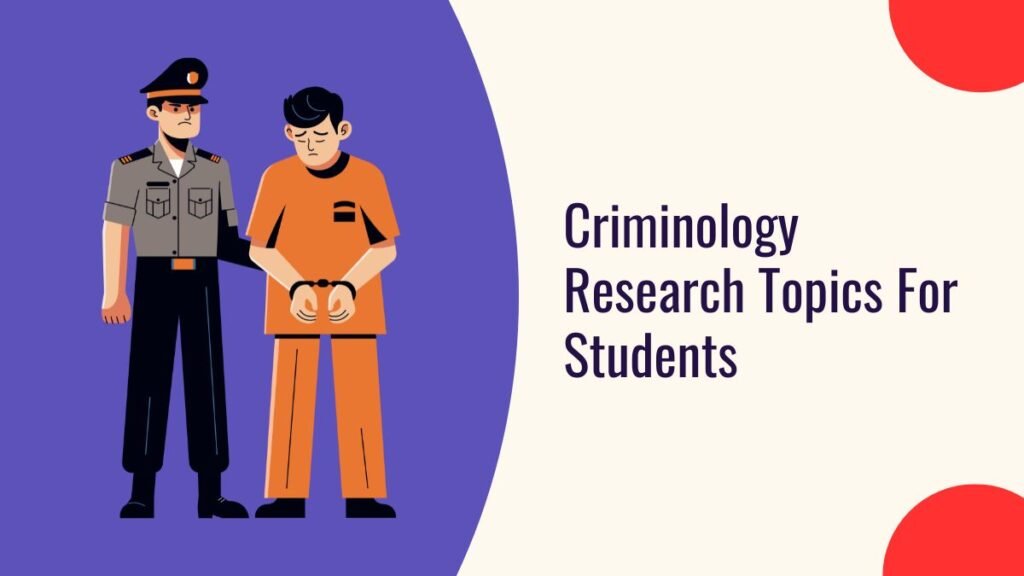Explore the most interesting criminology research topics for students, covering crime theories, justice systems, criminal behavior, and more for your next project or paper.”
What drives individuals to commit crimes? How can understanding criminal behavior contribute to a safer society? In a world where crime continues to pose significant challenges, the study of criminology becomes increasingly vital.
Criminology explores the complexities of criminal behavior, the societal impacts of crime, and the effectiveness of various responses to crime. By investigating the underlying causes of criminal activity, we can develop more effective prevention strategies and policies.
This blog will delve into the importance of criminology studies, examining key theories, societal influences, and emerging trends. From understanding the impact of poverty and inequality to analyzing the growing threat of cybercrime, this article aims to provide valuable insights for students and anyone interested in the field.
Whether you’re contemplating a career in criminology or simply want to understand the factors that shape criminal behavior, this exploration will equip you with a comprehensive overview of the field.
Criminology Research Topics For Students PDF
Key Theoretical Frameworks in Criminology
Understanding Theories that Shape Criminal Behavior
Criminology is rooted in several theoretical frameworks that help explain why crimes occur. Here are some of the most influential theories:
- Classical Theory: Focuses on the idea that individuals make rational choices to commit crimes, weighing the potential benefits against the risks of punishment.
- Biological Theories: Suggest that genetic and physiological factors may predispose individuals to criminal behavior.
- Social Learning Theory: Proposes that people learn behaviors through observation and imitation of others, particularly in their social environments.
- Strain Theory: Argues that societal pressures, such as poverty and lack of opportunity, can lead individuals to commit crimes as a means to achieve success.
Understanding these frameworks allows criminologists to analyze criminal behavior comprehensively and design effective interventions.
How Poverty and Inequality Influence Criminal Behavior
The Societal Impact on Crime
Poverty and inequality are significant factors influencing criminal behavior. Research indicates that areas with high poverty rates often experience higher crime rates. This correlation can be explained through several mechanisms:
- Limited Opportunities: Individuals in impoverished neighborhoods may have fewer legitimate economic opportunities, leading some to resort to crime.
- Social Disorganization: High levels of poverty can disrupt community cohesion, resulting in an environment where crime is more likely to occur.
- Psychological Stress: Economic hardship can increase stress and frustration, which may manifest in criminal behavior.
Addressing poverty and inequality is crucial for reducing crime rates and promoting social justice.
Understanding the Growing Threat of Online Crime
Cybercrime: A New Frontier
With the rise of technology, cybercrime has become a pressing issue. Understanding this growing threat requires an exploration of various aspects:
- Types of Cybercrime: Cybercrime includes hacking, identity theft, online fraud, and the distribution of child exploitation materials. Each type poses unique challenges for law enforcement.
- Victimization: Individuals and organizations alike can fall victim to cybercrime, resulting in financial losses and emotional distress.
- Law Enforcement Challenges: The anonymous nature of the internet complicates investigations, requiring specialized skills and international cooperation.
As society becomes more dependent on technology, the need for effective strategies to combat cybercrime becomes increasingly critical.
How News and Entertainment Influence Crime Awareness
The Role of Media in Shaping Perceptions
Media plays a significant role in shaping public perceptions of crime. The way news outlets and entertainment portray crime can influence societal attitudes and behaviors:
- Sensationalism: Media often sensationalizes crime, leading to fear and misconceptions about the prevalence and nature of criminal activity.
- Criminal Profiling: Portrayals of criminals in movies and TV shows can create stereotypes that impact how society views certain demographics.
- Public Awareness: While media can raise awareness about important issues, it can also contribute to moral panic and distorted perceptions of risk.
Understanding the media’s influence is crucial for criminologists aiming to educate the public accurately about crime and safety.
110+ Most Interesting Criminology Research Topics For Students
Here’s a list of interesting criminology research topics for students:
Theoretical Perspectives
- Theories of criminal behavior: Nature vs. nurture
- Social learning theory and its impact on criminal behavior
- The role of strain theory in understanding crime
- Exploring routine activity theory and crime prevention
- The impact of labeling theory on offenders
Crime and Society
- The relationship between poverty and crime rates
- The effects of neighborhood characteristics on crime
- Crime and the influence of media representations
- The role of community policing in reducing crime
- The impact of immigration on crime rates
Criminal Justice System
- The effectiveness of rehabilitation programs for offenders
- Exploring the racial disparities in sentencing
- The role of plea bargaining in the justice system
- The impact of mandatory minimum sentencing laws
- Analyzing the effectiveness of drug courts
Cybercrime
- The rise of cybercrime in the digital age
- Exploring the motivations behind cyberbullying
- The impact of social media on criminal activity
- Cybersecurity measures and their effectiveness
- The legal challenges of prosecuting cybercrime
Victimology
- The psychological impact of crime on victims
- Understanding the dynamics of domestic violence
- The role of victim advocacy in the justice process
- Exploring the concept of victim blaming
- The effects of crime on community cohesion
Youth and Crime
- The impact of gang involvement on youth
- Juvenile delinquency: Causes and prevention strategies
- The role of schools in preventing youth crime
- Understanding the effects of family structure on juvenile crime
- The impact of social media on youth criminal behavior
Crime Prevention
- Analyzing the effectiveness of crime prevention strategies
- The role of environmental design in crime prevention
- Community engagement and its impact on crime rates
- The effectiveness of neighborhood watch programs
- The role of technology in crime prevention
Homicide and Violent Crime
- The motivations behind serial killing
- Understanding domestic homicide: Causes and prevention
- The role of mental health in violent crime
- Analyzing the trends in gun violence
- The impact of media coverage on violent crime rates
Gender and Crime
- The role of gender in criminal behavior
- Analyzing the prevalence of female offenders
- The impact of gender-based violence on society
- Exploring the connection between masculinity and crime
- The role of feminism in shaping criminology
White-Collar Crime
- Understanding the motivations behind corporate crime
- The impact of white-collar crime on society
- Analyzing the effectiveness of regulations against fraud
- The role of ethics in business practices
- Exploring the relationship between power and white-collar crime
International Crime
- The impact of globalization on crime
- Understanding human trafficking and its consequences
- The role of international law in combating organized crime
- Analyzing the effects of terrorism on public safety
- The influence of transnational crime on national security
Rehabilitation and Reintegration
- The challenges of reintegrating ex-offenders into society
- The effectiveness of community service as a rehabilitation tool
- Analyzing educational programs for inmates
- The role of mental health services in offender rehabilitation
- Understanding recidivism and its contributing factors
Criminal Psychology
- The psychological profiles of violent offenders
- Understanding the motivations behind criminal behavior
- The role of psychopathy in criminal justice
- The impact of trauma on criminal behavior
- Analyzing the effectiveness of psychological evaluations in sentencing
Law Enforcement
- The impact of police brutality on community trust
- Analyzing the effectiveness of police training programs
- The role of technology in modern policing
- Community relations and their impact on crime rates
- The influence of public perception on policing strategies
Ethics in Criminology
- The ethical dilemmas faced by law enforcement
- Analyzing the ethics of surveillance in crime prevention
- The role of ethics in criminological research
- Understanding the balance between security and civil liberties
- The ethical implications of punishment and rehabilitation
Drug-related Crime
- The impact of drug addiction on crime rates
- Understanding the relationship between drug policy and crime
- Analyzing the effectiveness of harm reduction strategies
- The role of drug cartels in organized crime
- Exploring the effects of legalizing marijuana on crime
Crime Trends and Statistics
- Analyzing crime trends over the last decade
- The role of data analysis in understanding crime patterns
- The impact of socioeconomic factors on crime statistics
- The relationship between education and crime rates
- Understanding the challenges of collecting accurate crime data
Social Movements and Crime
- The influence of social movements on criminal justice policy
- Analyzing the role of protests in shaping crime legislation
- The impact of civil rights movements on policing practices
- Exploring the relationship between activism and crime
- The effects of public opinion on crime policy
Future of Criminology
- The impact of artificial intelligence on crime prediction
- Exploring the future of crime and criminal justice
- The role of virtual reality in criminology education
- Analyzing emerging trends in criminal behavior
- The influence of social media on future crime patterns
Comparative Criminology
- Comparing crime rates across different countries
- The impact of cultural differences on criminal behavior
- Analyzing international approaches to crime prevention
- The role of legal systems in shaping crime rates
- Understanding the differences in rehabilitation practices globally
Miscellaneous Topics
- The role of forensic science in solving crimes
- Analyzing the impact of celebrity culture on crime
- The relationship between economic inequality and crime
- Understanding the impact of mental illness on criminal behavior
- Exploring the effects of community trauma on crime rates
Special Focus
- Crime in the age of COVID-19
- The relationship between environmental crime and policy
- Understanding the role of virtual crime in society
- The influence of cultural narratives on crime perception
- Exploring the intersection of criminology and public health
Exploring Factors Leading to Youth Crime
Understanding the Influences on Young Offenders
Youth crime is a complex issue influenced by various factors. Key elements include:
- Family Environment: Children from dysfunctional families may be more susceptible to engaging in criminal behavior.
- Peer Influence: Peer pressure can significantly impact youth decisions, leading to criminal activity as a means of acceptance.
- Educational Challenges: Lack of educational opportunities and engagement can push youth toward delinquency.
- Societal Factors: Neighborhood violence and community disorganization can create environments conducive to crime.
Addressing these factors requires a holistic approach involving families, schools, and communities.
Examining the Relationship Between Gender and Criminal Activity
Gender Differences in Crime
Gender plays a crucial role in understanding criminal behavior. Research highlights the following trends:
- Differences in Types of Crime: Males are more likely to engage in violent crimes, while females often commit property crimes or drug-related offenses.
- Socialization Effects: Gender socialization influences behavior, with societal expectations shaping how men and women express aggression and resolve conflicts.
- Victimization Rates: Women are often disproportionately affected by certain types of crime, particularly domestic violence and sexual assault.
Understanding these dynamics is essential for developing gender-sensitive approaches to crime prevention and intervention.
Analyzing Processes, Challenges, and Reforms in the Criminal Justice System
A Critical Look at the System
The criminal justice system is a complex entity facing numerous challenges. Key areas of analysis include:
- Inequality in Enforcement: Disparities in how laws are enforced can lead to racial and socioeconomic inequalities in the justice system.
- Rehabilitation vs. Punishment: The debate between rehabilitative and punitive approaches to justice continues to influence policies and practices.
- Public Perception: Understanding public attitudes toward the criminal justice system can inform reforms and enhance community trust.
Effective reforms must address these challenges to create a more just and equitable system.
Understanding the Link Between Psychological Disorders and Crime
The Mental Health-Crime Connection
The intersection of psychology and criminology reveals important insights into criminal behavior:
- Mental Health Disorders: Certain psychological disorders, such as antisocial personality disorder, can increase the likelihood of criminal behavior.
- Substance Abuse: There is a strong correlation between substance abuse and criminal activity, as individuals may commit crimes to support their addiction.
- Treatment Needs: Understanding the mental health needs of offenders can inform rehabilitation strategies and reduce recidivism.
Integrating mental health services into the criminal justice system is crucial for effective intervention.
Exploring the Rights and Needs of Crime Victims
Victimology: A Critical Perspective
Victimology focuses on the experiences and needs of crime victims. Key considerations include:
- Rights of Victims: Advocating for the rights of victims is essential for ensuring they receive support and justice.
- Impact of Crime: Understanding the psychological, emotional, and financial impacts of crime on victims can inform support services.
- Restorative Justice: Exploring restorative justice practices can help heal relationships between victims and offenders, promoting rehabilitation and reconciliation.
Recognizing the needs of victims is vital for creating a comprehensive approach to crime prevention and justice.
Investigating Mafia and Gang Activities
Organized Crime: A Persistent Threat
Organized crime, including mafia and gang activities, poses significant challenges for law enforcement. Key factors include:
- Structure and Operations: Understanding the hierarchical structure of gangs and organized crime groups is essential for effective intervention.
- Economic Impact: Organized crime often infiltrates legitimate businesses, undermining economies and contributing to violence.
- Community Influence: Gangs can exert significant influence over communities, leading to cycles of violence and fear.
Addressing organized crime requires a multifaceted approach involving law enforcement, community engagement, and prevention strategies.
Examining the Relationship Between Substance Abuse and Criminality
Addiction and Crime
The link between substance abuse and criminal behavior is well-documented. Key insights include:
- Criminalization of Addiction: Many individuals turn to crime to support their drug habits, leading to cycles of addiction and incarceration.
- Impact on Communities: High rates of substance abuse can destabilize communities, contributing to crime and social disintegration.
- Rehabilitation Approaches: Effective interventions must include comprehensive substance abuse treatment to reduce crime and promote recovery.
A holistic approach to addressing substance abuse and crime is essential for fostering healthier communities.
Debating the Morality and Effectiveness of Capital Punishment
The Death Penalty: A Controversial Issue
Capital punishment remains one of the most contentious issues in criminology. Key points of debate include:
- Moral Considerations: Opponents argue that taking a life is inherently wrong, while supporters contend it serves as a deterrent.
- Effectiveness: Studies examining the deterrent effect of the death penalty yield mixed results, challenging its effectiveness as a crime prevention tool.
- Discrimination in Sentencing: Research indicates racial and socioeconomic biases in capital punishment cases, raising concerns about justice and fairness.
Engaging in informed discussions about capital punishment is essential for understanding its implications within the criminal justice system.
Analyzing Issues of Race and Discrimination in Law Enforcement
Racial Disparities in the Criminal Justice System
Race and discrimination play significant roles in shaping the experiences of individuals within the criminal justice system. Key considerations include:
- Racial Profiling: Discriminatory practices in policing can lead to racial profiling, exacerbating tensions between law enforcement and communities of color.
- Disparities in Sentencing: Research shows that minority groups often face harsher sentences compared to their white counterparts for similar offenses.
- Community Trust: Building trust between law enforcement and marginalized communities is crucial for effective policing and crime prevention.
Addressing issues of race and discrimination is vital for fostering a fair and equitable criminal justice system.
How Advances in Tech Are Changing Criminal Tactics?
The Digital Landscape of Crime
Technological advancements are reshaping the landscape of crime and law enforcement. Key areas of focus include:
- Cybercrime Tactics: Criminals are increasingly utilizing technology to commit crimes, from online fraud to hacking.
- Law Enforcement Tools: Advances in technology enable law enforcement to develop more sophisticated investigative techniques, including data analytics and surveillance.
- Ethical Considerations: The use of technology in policing raises ethical questions about privacy, surveillance, and civil liberties.
Staying informed about the impact of technology on crime is essential for developing effective responses.
Exploring Alternatives to Traditional Punishment
Innovative Approaches to Justice
The search for alternatives to traditional punitive measures is gaining momentum. Key strategies include:
- Restorative Justice: This approach emphasizes repairing harm done to victims and reintegrating offenders into the community.
- Diversion Programs: Programs that redirect offenders away from the criminal justice system can reduce recidivism and promote rehabilitation.
- Community-Based Interventions: Involving communities in the rehabilitation process can lead to more effective and sustainable outcomes.
Exploring these alternatives is crucial for creating a more humane and effective justice system.
Understanding Causes, Impacts, and Solutions to Human Trafficking
A Global Crisis
Human trafficking is a pervasive issue with deep societal impacts. Key insights include:
- Causes: Factors such as poverty, inequality, and lack of education contribute to the vulnerability of individuals to trafficking.
- Impacts: Victims of trafficking suffer severe physical and psychological harm, with long-lasting consequences.
- Solutions: Combating human trafficking requires a multifaceted approach, including legal reforms, victim support services, and awareness campaigns.
Addressing this crisis is essential for promoting human rights and dignity.
Examining Non-Violent Crimes Committed for Financial Gain
Understanding Financial Crimes
Non-violent crimes, particularly those committed for financial gain, represent a significant area of concern. Key aspects include:
- Types of Non-Violent Crimes: White-collar crimes, fraud, embezzlement, and cybercrimes often have devastating financial impacts on individuals and organizations.
- Motivations: Understanding the motivations behind these crimes can inform prevention strategies and legal responses.
- Economic Consequences: The economic ramifications of non-violent crimes can ripple through communities, affecting overall stability and security.
Addressing non-violent crimes is essential for safeguarding economic integrity.
Effective Approaches to Reducing Crime Rates
Strategies for Safer Communities
Reducing crime rates requires a comprehensive approach that addresses the root causes of crime. Effective strategies include:
- Community Policing: Building strong relationships between law enforcement and communities can foster cooperation and trust.
- Prevention Programs: Investing in education, job training, and youth engagement programs can reduce crime by addressing underlying issues.
- Mental Health Support: Providing mental health resources and treatment can address the psychological factors contributing to criminal behavior.
Implementing these strategies can lead to safer and more resilient communities.
Emerging Trends and Areas for Further Research in Criminology
The Future of Criminology Studies
As society evolves, so too does the field of criminology. Emerging trends and areas for further research include:
- Cybercrime and Digital Justice: Understanding the implications of the digital age on crime and justice will be crucial in the coming years.
- Mental Health and Crime: Further research into the mental health factors influencing criminal behavior can lead to better intervention strategies.
- Restorative Justice Practices: Exploring the effectiveness of restorative justice in various contexts can inform future practices and policies.
The future of criminology promises to be dynamic and responsive to the challenges of an ever-changing world.
Final Thoughts
Criminology is a multifaceted field that plays a critical role in understanding crime and developing effective responses. From examining the social and psychological factors that influence criminal behavior to exploring the complexities of the criminal justice system, the insights gained from criminology studies are invaluable.
As you continue to explore this fascinating field, consider how you can contribute to reducing crime and promoting justice in your community. Whether through research, advocacy, or direct involvement in the criminal justice system, your engagement can lead to meaningful change. By deepening our understanding of crime and its impacts, we can work together toward a safer and more just society for all.



